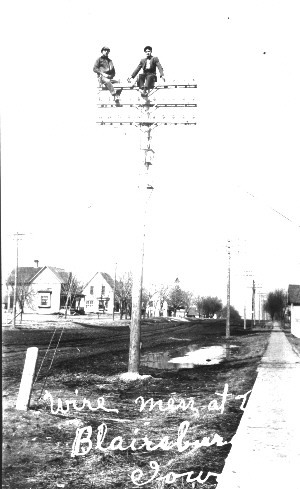Blairsburg, Iowa - Founded in 1869
By Martin E. Nass
Transcribed for the IAGenWeb Project by Janelle Martin, with permission of Martin "Ed" Nass.
Five Webster City men, who felt that the Dubuque and Pacific Railroad would have
to come to this area soon, platted the town of Hawley in SE Sec 36-89-24 on December
7, 1857. They were George Grechneck, Thomas J. McCartney, Walter C. Willson, Sumler
Willson, and Jacob M. Funk. Hawley was the chief engineer of the railroad at the
time. The railroad did not come as quickly as the men expected.
In 1869, John I. Blair was the chief engineer of the railroad, now called the Dubuque
and Sioux City Railroad. He came to the area to gain concession of land from the
Hawley investors. When they refused, he platted his own town in NW/NE Sec 35-89-24
and named it for himself. It was about a mile north of Hawley. The new town grew
very slowly. By 1880 there were only 44 people living here. By 1900 it had grown
to 260, and to 270 by 1969. In 1980 it peaked at 288. Since then the population has
been in a gradual decline. Today Blairsburg's population is listed at 269.
Blairsburg Line Crew.

Electricity comes to Blairsburg in the early 1920's. This pictures shows the line crew stringing
the first wires in the business district.
The first settler in the town was Robert Tinling. A post office was established,
and Gilbert Blair was the first postmaster. An early postal listing gave the town
spelling as Blairsburgh, but the town plat was spelled without the "h."
The first state road passed along the south edge of town and along the north shore
of Blairsburg Lake. A thick grove of trees made the road very dark some nights, so
lanterns were hung in the trees to light the way for travellers. The lake was a very
shallow lake that was a popular spot for fishing and hunting. So many hunters lost
their guns overboard that the name was commonly called "Shotgun Lake."
At one time Ed Mabbott of Webster City brought over his small steamboat, the Daniel
Boone, to give rides on this lake.
The first school house in town was built in 1870 - a one room ungraded school taught
by Jennie Toughtaling. There were 40 pupils in this school. By 1877 the school population
grew to 55. Mr. James McNee was paid $25.00 a month to teach. By 1894 the school
became an independent school district ,and a two story wooden building was built
in 1898. By then the school was graded, with two teachers handling the eight grades.
Creation of a consolidated district took place in 1914 and a four year high school
was added. By 1918 there were nine teachers as the school worked to become accredited.
Since the district now had pupils from 26 sections, school "hacks" were
employed to haul the children to school. The drivers blew whistles to alert the children
they were coming. Music and sports were introduced in 1918, and a third floor was
added to the school. In 1952 a west portion was added and a gymnasium was completed.
A reorganization of the school was completed in 1962 when Blairsburg, Kamrar, and
Williams were merged. The first graduating class of Northeast Hamilton occurred in
1963. The school now has 375 students in grades K-12, employs about 30 teachers (some
part-time) and runs six bus routes.
U. S. Highways 20 and 69 intersect at the southeast corner of Blairsburg. For many
years this was a busy spot with travellers stopping at restaurants and service stations.
The bus depot was located at the Standard gas station for many years. This intersection
was known as "Blairsburg Corners."
In recent years, the Opera House has been restored and is a source of pride for the
community as plays and other activities take place here. The highway travel has diminished
with the creation of Interstate 35 and U. S. 20, so the activity level has slowed
down. Someone in Blairsburg has laughingly said, "When the buses unload the
pupils at Northeast Hamilton, the town population more that doubles." A high
school student was heard saying, "If I see one car on Main Street when I drive
to school I know that we are going to have a busy day." It is hard to imagine
that at one time the business district stretched for several blocks, and on Saturday
nights it was a thriving center of activity.
|